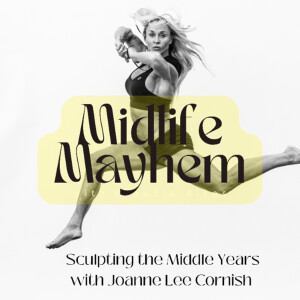

Episode summary
Your waist isn’t just “aesthetic”—it’s a metabolic dashboard. In this episode, Joanne breaks down why central fat (especially visceral fat) screams insulin resistance, tanks testosterone in men, drives unfavorable estrogen dynamics in women, and turns up the dial on inflammation, fatty liver, and long-term disease risk. You’ll learn simple ways to measure risk at home, where the classic inch cut-offs came from, why waist-to-height ratio may be even better, and how to shrink visceral fat without living in the gym.
Quick hits
-
The “portal theory”: belly fat drains inflammatory fats straight to your liver → insulin resistance and fatty liver. PMC+1
-
Risk thresholds: >35" (88 cm) for women, >40" (102 cm) for men = higher cardiometabolic risk. NHLBI, NIH+1
-
Waist-to-Height Ratio: aim for <0.5 (waist less than half your height). Works for adults and kids. PMC+1
-
Men: more visceral fat ↔ lower testosterone; losing central fat helps restore it. PMC+2PMC+2
-
Women (post-meno): larger waistlines link to higher breast-cancer risk. PMC+1
What we cover
-
Why waist beats BMI for individuals (and where BMI still helps). Health
-
How visceral fat hijacks metabolism (liver first, then the rest). ScienceDirect
-
Hormones: low T in men; estrogen metabolism and risk signals in women. PMC+2PMC+2
-
Why kids’ waists matter now (same <0.5 rule applies). PMC
-
Stress, sleep, and the “cortisol waistline” loop (why stress management isn’t optional).
-
Fixes that actually work (beyond “eat less, move more”).
How to measure at home (30 seconds)
-
Stand, relax, tape measure just above hip bones (at the navel level works for consistency).
-
Exhale normally; measure without sucking in.
-
Note waist in inches/centimeters and your height.
-
Calculate WHtR = waist ÷ height. Target <0.5. NHLBI, NIH+1
Science spotlight (plain-English)
-
Portal theory: Visceral fat drains to the liver via the portal vein, delivering free fatty acids and inflammatory signals → liver insulin resistance → higher glucose and triglycerides. PMC+1
-
Hormones & midlife: Central adiposity lowers male testosterone (partly via SHBG changes and inflammation); reductions in waist often improve T. PMC+1
-
Women & cancer risk: In post-menopause, higher waist/central fat correlates with higher breast-cancer risk—another reason to track the tape, not just the scale. PMC+1
-
Why WHtR wins: It adjusts for height and flags risk across ages and ethnicities; <0.5 is a practical universal cut-off (including children). PMC
Action plan (doable this week)
-
Protein first: 1 g per lb of goal body weight (your signature guidance) to protect muscle and make fat loss easier.
-
Two strength sessions + two brisk cardio blocks: Short, consistent training beats heroic weekends.
-
Fiber up: Aim 30–40 g/day from real food; helps glycemic control and appetite.
-
Carb timing: Push starchy carbs around training or active windows.
-
Sleep & stress: 7–8 hrs, and one daily stress-down tool (walks, breathwork, yoga).
-
Track two numbers for 8 weeks: waist (in) and WHtR. If they’re falling, visceral fat is falling.
Resources mentioned
-
Risk cut-offs (US guidance): Women >35", Men >40". NHLBI, NIH+1
-
WHtR guide (<0.5): Adults & children. PMC
-
Mechanism explainer (portal theory): Why belly fat hits the liver first. PMC+1
Links & how to connect
-
Programs & details: midlifemonth.com (Mastering Midlife)
-
Coaching, programs, and supplements: theshrinkshop.com
-
Podcast hub: joanneleecornish.podbean.com
-
Deep dives on 5-Amino-1MQ and SLU-PP-332: 5amino.com, slu332.com
-
Email Joanne: jo@theshrinkshop.com
More Episodes
All Episodes>>You may also like
Create Your Podcast In Minutes
- Full-featured podcast site
- Unlimited storage and bandwidth
- Comprehensive podcast stats
- Distribute to Apple Podcasts, Spotify, and more
- Make money with your podcast












